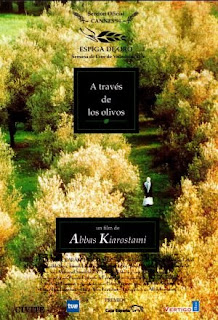 This is the final film of Kiarostami’s Koker trilogy, which began with Where is the Friend’s House? and And Life Goes On…. The films in this trilogy got progressively more ‘arty’ as it went along, and self-referential. Friend’s House is a simple film about a boy’s journey to help his friend, then And Life shows a man who represents Kiarostami searching for a boy from Friend’s House, and now Through the Olive Trees features two men who represent Kiarostami. The trilogy peels away one layer of fiction to reveal something supposedly non-fiction, and then turns around and peels back again to completely fuzz what is and isn’t reality. Kiarostami seems to compulsively create fiction about non-fiction, and doesn’t know when to quit.
This is the final film of Kiarostami’s Koker trilogy, which began with Where is the Friend’s House? and And Life Goes On…. The films in this trilogy got progressively more ‘arty’ as it went along, and self-referential. Friend’s House is a simple film about a boy’s journey to help his friend, then And Life shows a man who represents Kiarostami searching for a boy from Friend’s House, and now Through the Olive Trees features two men who represent Kiarostami. The trilogy peels away one layer of fiction to reveal something supposedly non-fiction, and then turns around and peels back again to completely fuzz what is and isn’t reality. Kiarostami seems to compulsively create fiction about non-fiction, and doesn’t know when to quit.
This film takes two seemingly insignificant characters from And Life and creates a new fiction underneath the fiction. The film is about non-fiction, and yet it is fictitious. I feel like I’m trying to write about a Charlie Kaufman film right now, but there are some very fresh things happening in this trilogy that go beyond Kaufman’s study of art’s imitation of life (and vice versa). First, Kiarostami is playing with the memory of his past films in a way that I am crazy about. With each film, the ideas become more and more enhanced by whether or not I was paying close enough attention to the previous film. I actually had no idea who Hossein and Tahereh were until about two-thirds of the way through this film it clicked and I felt silly for not making the connection before. These are sequels that actually embellish the previous films rather than rehash or thin out the themes of the predecessors.
But beyond the mirrors and reflections involved in the trilogy, each of the three films still focuses on its own ground. Through the Olive Trees, despite being based on characters from And Life, has its own goals and ideas that are separate. Hossein is madly in love with Tahereh, but his class and illiteracy keep him from having her. Tahereh is controlled by her grandmother, and is, consequently, bitchily unresponsive to simple comments and questions from Hossein. The culture and traditions specific to this region come between them and its frustrating to watch.
One trait of Kiarostami’s filmmaking that I’ve noticed is his characters’ repetitive and persistent nature. The children ask questions up to a dozen times before they get the answer they want or are finally convinced that they aren’t going to get their desired response. The filmmaker in this film (the actual one, not the fictitious one from And Life) goes through take after take as the stubborn actors change the script, often to make some sort of point. Tahereh will not call Hossein ‘Mr Hossein’ because the women in the region do not say ‘Mister’ and Hossein says that 25 family members died in the earthquake for three or four takes before he succumbs to the inaccurate total of 65 that the filmmaker is asking him to say.
Which brings up probably my favorite theme in this film: the actors’ resistance to fictionalizing their lives. The rules of the culture are constantly interrupting and altering the fiction that the filmmaker is trying to portray. In the final scene of the film, Hossein ceaselessly begs for Tahereh’s hand in marriage, but she will not budge on what she has been told. In the last moments, Hossein has either given up, or Tahereh has finally said yes. Hossein, chasing Tahereh in a zig zag up until now, breaks the motif of the trilogy and stumbles diagonally back toward the camera.
